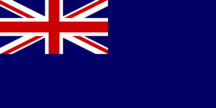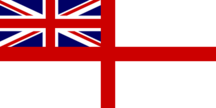British ensigns
|
|

British-Merchant-Navy-Ensign.png
This article concerns the ensigns flown by vessels and aircraft of the United Kingdom and its overseas territories.
In British maritime law and custom, the ensign proper to a British ship is one of several flags with a red, white or blue field, with the Union Flag in the canton (the upper corner next the staff), known as the red(or scarlet), blue and white ensigns respectively. Outside the nautical sphere, there are some flags which are modelled on the red, white and blue ensigns, but which use more unusual colours, e.g. the sky blue of the Royal Air Force ensign.
The Union Flag (informally known as Union Jack) is not worn at sea except by Royalty or by Royal Navy vessels that carry the designation Her Majesty's Ship eg HMS Ark Royal.
| Contents |
Modern usage
Since the reorganisation of the Royal Navy in 1864, the white ensign (a red St George's Cross on a white field with the Union Flag in the upper canton) is worn by the Royal Navy, the Royal Yacht and the Royal Yacht Squadron.
The blue ensign (dark blue field with the Union Flag in the upper canton) is the ensign of the Royal Naval Reserve (RNR) and of certain ships whose masters are officers in the RNR. British government departments use a variety of blue ensigns defaced in the fly with the department badge, and colonial governments use blue ensigns defaced with the colonial badge. The flag of Australia and those of its states as well as the flag of New Zealand are defaced blue ensigns.
The red ensign (red field with the Union Flag in the upper canton) is for the use of the Merchant Navy and all private craft. It is also the only correct flag to be worn as courtesy flag by foreign vessels in United Kingdom waters.
Many yacht clubs have royal warrants authorising them to fly "privileged" ensigns other than the red ensign, for example the blue ensign, or red or blue ensigns defaced with the club's badge. The Royal Yacht Squadron is unique as it is allowed to fly the white ensign.
Other ensigns
British-Civil-Air-Ensign.png
Royal-Air-Force-Ensign.png
There exist also a Royal Air Force (RAF) ensign and a civil air ensign, both of which have a sky blue field, with the Union Flag in the canton. The RAF ensign is defaced with the red-white-blue RAF roundel, while the field of the civil air ensign is charged with a large dark blue cross fimbriated white. The flag of Tuvalu and that of flag of Fiji are defaced sky blue ensigns.
The flag of Niue, a self-governing dependency of New Zealand, is a yellow ensign. Even more unusually, it is the Union Flag canton rather than the fly which is defaced with a modified Southern Cross.
Registered yacht owners resident in the Isle of Man can fly a Manx Ensign, which is composed of a British red ensign defaced with a Triskelion at the fly end.
The flags of the British Antarctic Territory has a white field defaced with the Territory's badge, while the British Indian Ocean Territory flag has a white and blue wavy-striped field, also defaced.
The flag of the British East India Company, like the Cambridge or Grand Union Flag of the American colonies, had a red and white striped field. There were similar red-and-white and green-and-white striped ensigns in the English Navy in the 16th century. The flag of Hawaii has white, red and blue stripes.
History
Prior to 1864, red, white and blue were the colours of the three squadrons of the Royal Navy, which were created as a result of the reorganisation of the navy in 1652 ? by Admiral Robert Blake. Each squadron flew one of the three ensigns.
The red squadron tended to patrol the Caribbean and north Atlantic, the white the coasts of Britain, France and the Mediterranean, while the blue patrolled the south Atlantic, Pacific and Indian oceans. The flags of the various former British colonies often have grounds of the same colour as their protective squadron. Hence Bermuda has a red ground and Australia and New Zealand blue. The flag of the United States also follows this pattern. Early flags of the American Revolution were modified Red Ensigns. The Grand Union flag, added six white stripes to the Red Ensign and this flag was used during the fight for independence until the Union Flag in the corner was replaced by the current stars in 1777.
In addition to the Admiral of the Fleet (who was Admiral of the Red), each squadron also had its own Admirals, Vice Admirals and Rear Admirals, e.g. Lord Nelson was Vice Admiral of the White at time of death.
Canadian ensigns
In 1868, the British Admiralty made the Canadian Blue Ensign the proper flag for ships of the Canadian government, and in 1892, the Admiralty approved the use of the Canadian Red Ensign by Canadian merchant ships. A blue ensign with the province's coat of arms in the fly was used as the Flag of Quebec until 1950.
From about 1870, Canada unofficially used a Red Ensign with the arms of its provinces on one shield as its national flag (the Canadian Red Ensign). In 1924, an order-in-council made the flag official (for certain purposes) and replaced the provincial arms with the royal arms of Canada. The red ensign was replaced by the current red and white maple-leaf flag in 1965. In that same year, the provinces of Ontario and Manitoba adopted red ensigns defaced by their provincial arms as their provincial flags. (see Flag of Ontario and Flag of Manitoba)
Sources
Flags and flag etiquette. In Fowler, Jean (Ed.): Reed's Nautical Almanac 1992, pp. 13:1-13:8. East Molesey: Thomas Reed Publications. ISBN 0947637966
See also
- Blue Ensign
- Red Ensign
- List of flags
- Maritime flags
- Union Flag
- Flag of Australia
- Flag of Canada
- Flag of Tuvalu
- List of Canadian provincial and territorial symbols
- UK topics
External links
- Flags of the World - British ensigns (http://www.fotw.net/flags/gb-ensig.html)
- Flags of the World - History of British ensigns (http://www.fotw.net/flags/gb-enshs.html)nl:Britse vaandels

